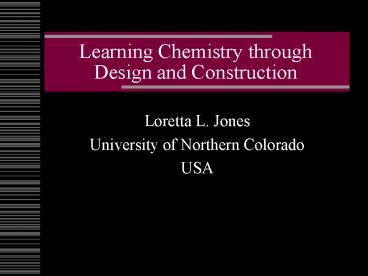Learning Chemistry through Design and Construction PowerPoint PPT Presentation
1 / 28
Title: Learning Chemistry through Design and Construction
1
Learning Chemistry through Design and Construction
- Loretta L. Jones
- University of Northern Colorado
- USA
2
What does it mean to design?
- to design
- to conceive and plan out in the mind
- to make a drawing, pattern or sketch
- Websters New Collegiate Dictionary
3
Why design?
- Design processes are important
- in daily life
- our appearance (clothing, hair style, etc.)
- our lifestyle (behavior, exercise, etc.)
- in industry
- drug design
- new materials
4
Why design?
- Introductory chemistry courses focus mainly on
discovery and analysis. - Chemists also design experiments and materials.
5
Design activities require different thought
processes than analysis does.
- Design
- Generate ideas.
- Make a plan.
- Draw a sketch.
- Analysis
- Evaluate ideas.
- Follow a plan.
- Interpret a sketch.
6
Why design?
- Authentic scientific activities what scientists
do. - School science activities what children do.
These activities often are not authentic science. - Design activities are authentic science that
children can do.
7
Authentic Science
- Scientists
- Make observations
- Formulate problems
- Search for information
- Design experiments and materials
- Make and check predictions
- Make discoveries
8
School Science
- Children
- Solve problems for which the answers are
already known. - Report laboratory work by filling in blanks.
- Memorize information.
- Take multiple-choice tests.
- School science is not authentic science.
- However, inquiry activities are authentic
science.
9
How can we provide design activities for students?
- Design activities require more effort from the
teacher. - Fortunately, computers can help.
10
Four kinds of design activities
- Designing laboratory experiments
- Designing molecular structures
- Designing substances and crystals
- Designing reactions and solutions
11
Designing experiments
- Comprehensive Chemistry Curriculum
12
Designing molecular structures
- Molecular modeling software (WebLab ViewerPro,
HyperChem, etc.)
See www.pro3.chem.pitt.edu/workshop/workshop_repor
t_180701.pdf
13
Designing substances and crystals
- ChemDiscovery (www.chemdiscovery.com)
14
Designing reactions and solutions
- Visualization CD for Chemistry Molecules,
Matter, and Change
Also see www.whfreeman.com/bridgingtothelab
15
Does it work?
- Comprehensive Chemistry
- 21 college students who did multimedia design
simulations scored higher on a test than 49
college students who did a verification
laboratory.
16
Do design activities prepare students for
practical work?
- Comprehensive Chemistry
- 26 college students designed virtual experiments
that used a spectrometer simulation. - 22 college students read the spectrometer manual.
- Later, in the laboratory, the students who had
designed virtual experiments took less time and
made 1/3 as many errors as students who read the
manual. They could use the spectrometer as though
they had used it before.
17
Do design activities change the secondary school
classroom?
- ChemDiscovery observations
- Two secondary schools
- Two classes taught by a teacher at each school
- Two experimental (ChemDiscovery)
- Two control (Traditional)
- Two observers one per school
- Observations made every 5 minutes
- Twelve visits to each site
18
Summary of findings
- Students are more active.
- Teachers spend more time facilitating student
work and less time lecturing.
19
Teachers Role
20
Using ChemDiscovery (Eufala High School,
Alabama)
21
What We Have Learned
- Design activities help students to learn
chemistry and to be more independent. - Design activities help students to develop
authentic scientific skills. - Computers can facilitate the use of design
activities.
22
Resources for Teachers
- www.dlese.org, www.nsdl.org
- serc.carleton.edu
- http//www.scienceyear.com/wired/index.html.
- Select Planet 10, then Play, World Builder.
- atlas.geo.cornell.edu/education/student/continenta
l_puzzle.html - Physics www.physics.unco.edu/pt3
- Chemistry www.whfreeman.com/chemcom/
- All http//www.scienceonestop.com
- Biology http//www.accelrys.com/gallery/
- http//www.umass.edu/microbio/rasmol/
23
24
(No Transcript)
25
(No Transcript)
26
(No Transcript)
27
Acknowledgements
- National Science Foundation
- W. H. Freeman and Company
- Coauthors
- Comprehensive Chemistry Curriculum
- Stanley Smith and Steve Gammon
- ChemDiscovery
- Olga Agapova and Alex Ushakov
- Bridging to the Lab/Visualization CD
- Roy Tasker, University of Western Sydney, CADRE
28
Software to investigate today
- Chemistry
- ChemDiscovery
- Bridging to the lab
- Molecular modeling
- Earth science and biology
- Digital library for Science education
- SERC
- Worldwatcher
- Physics
- Online inquiry modules
- www.sciencenetlinks.com

